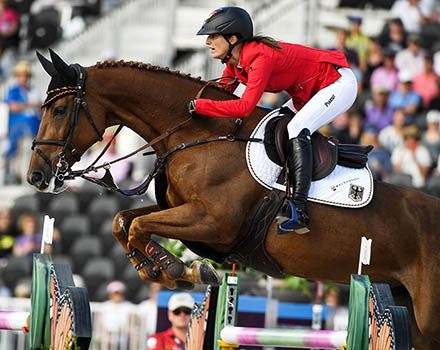
By Judy Wardrope
Photography: FEI
This author is old enough to recall the days when the majority of competition horses were male. They were either stallions establishing their abilities in hopes of a more successful breeding career, or geldings. Mares were primarily breeding stock, and sometimes to the extent that they were only given numbers, not names. Check the tail female line of such horses as Sandro Hit, and you will find such mares.
In those days, some experts said that mares did not have the right temperament for competition, nor the right pelvis, particularly for dressage. But were those things really true or just a common belief?
The horses on the list of the 2005 World Cup classes were almost entirely male: Debbie McDonald’s medal-winning mare, Brentina (Brentano II - Lieselotte x Lungau would be the exception, of course. Conrad Schumacher of Germany, a highly respected coach on both sides of the Atlantic as well as a very popular clinician, had an explanation: “Mares have a different pelvis, that’s why we don’t see a lot of mares at the top of our sport.” As to temperament, Schumacher added, “Stallions sometimes work against themselves.”
Brentina was certainly a door-opener when it came to mares being taken seriously in dressage, and the Danish Warmblood Blue Hors Matine (1997: Silvermoon - Matadie x Matador, bred by Inger Katballe) shone brightly a few years later. Now it is mares the likes of Bella Rose (2004: Belissimo - Cadra II x Cacir AA, bred by Heinrich and Wilhelm Strunk) that lead the way.
Joe Fargis had a stellar reputation in the jumpers with mares: Touch of Class (1984 individual Olympic gold), Mill Pearl (1988 Olympic team silver), and Diams III (1991/SF: Royal Feu - Utelle d’Eawy x Duc de Ferce, bred by Romain and Marie Lecuyer). Ludger Beerbaum still refers to Ratina Z (individual silver and team gold at the Barcelona 1992 Olympic Games with Piet Raijmakers, plus Atlanta 1996 team gold and 1994 WEG team gold with Ludger), as one his very best rides. And let us not forget Anka 191 (Argentinus - Wenke x Waldmann, bred by G. Jansen), the 2003 World Cup showjumping champion with Marcus Ehning. Mares can certainly jump!
As to the temperament issue, Fargis offered, “If you have a good gelding you have a good horse. If you have a good stallion, you have a good horse. But, if you have a good mare, you have a great horse.” He went on to explain that geldings can get lazy and that stallions can cheat, but a good mare will keep fighting for you, trying to keep you out of trouble.”
In the eventing world, mares the likes of Jenny Camp (Slyguff Joker VII - Mandy Offers x Ozymandias), Headley Britannia (Jumbo - Alan’s Bambi) and FischerRocana FST Ituango xx - Rose II x Carismo, bred by Mirko Glotz) have made sure that their male counterparts understood the definition of girlpower through the three phases of their demanding sport. But maybe that isn’t so new. In 1912, the first appearance of modern equestrian disciplines at an Olympic Games, the eventing gold medalist, Axel Nils August Nordlander (SWE), rode a horse named Lady Artist, while the bronze medalist, Jacques Cariou (FRA), was aboard Cocette – which certainly sound like female names.
Although 2018 was not a ‘normal’ World Equestrian Games in terms of dressage, let’s see how the mares fared.
Dressage boasts two team gold mares
In the team competition, there were a total of 15 teams of four horses comprising 31 geldings, 22 stallions and seven mares. Once the scores were tallied, two of the mares won team gold (TSF Dalera BB and Bella Rose, Germany), and one team bronze (Mount St. John Freestyle, Great Britain). The fourth-placed team (Sweden) also boasted a mare, Well Done de la Roche CMF. Amazingly not one of these mares represented the drop score for their respective teams. In fact, three of them had the highest scores on their teams, and the remaining mare represented victorious Germany...CLICK HERE TO SUBSCRIBE TO BREEDING NEWS
SUBSCRIBERS CAN READ THE COMPLETE ARTICLE BY LOGGING IN AND RETURNING TO THIS PAGE




